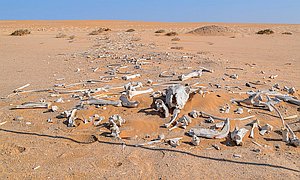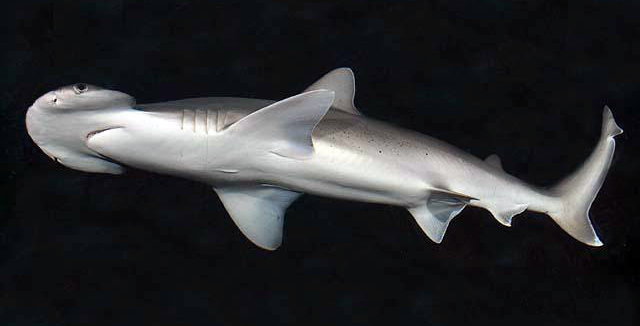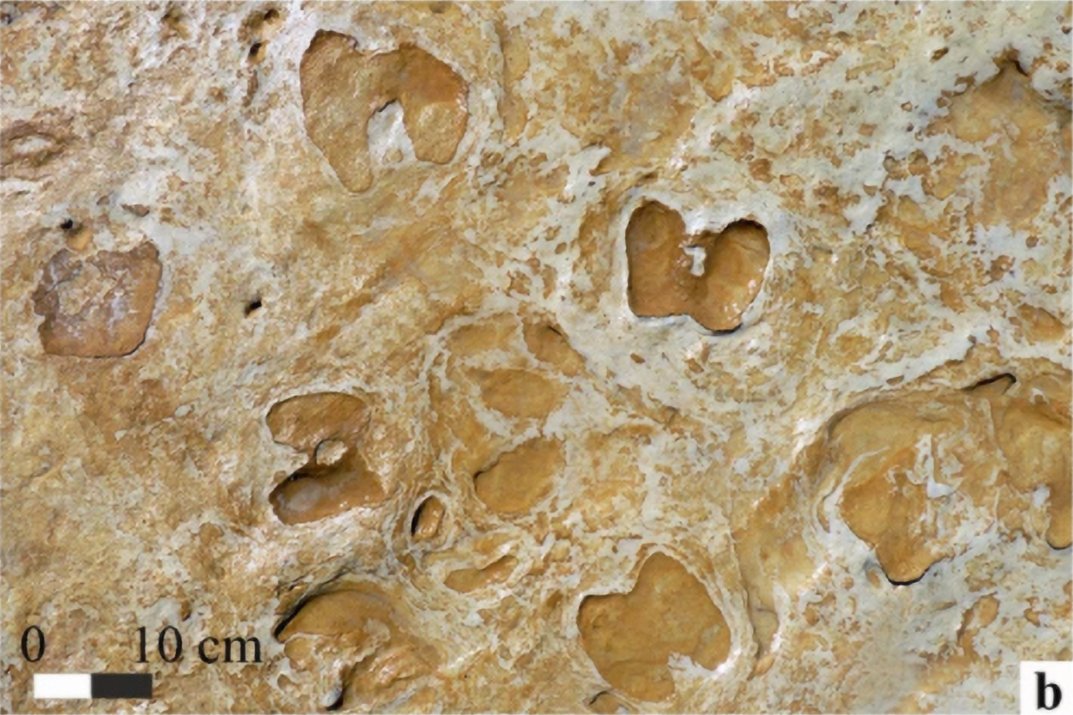Focus 43(4)
creation news and views
Huge crocodiles roamed central Australia

A special exhibit in the Museum and Art Gallery of the Northern Territory features a large crocodile skull. It was recovered 200 km (125 miles) north of Alice Springs in the middle of Australia. The find points to a climate very different from the parched and barren landscape there at present. Dr Adam Yates, senior curator of earth sciences at the Northern Territory Museum said, “It’s somewhat surprising to imagine that central Australia had rivers to support crocodiles.”
However, it is not surprising from a biblical perspective. Enormous ‘rivers’ flowed across the continent at the tail-end of Noah’s Flood, as the last of the floodwaters drained into the oceans, some 4,500 years ago. They carried sediment and the decomposing remains of animals that perished earlier in the Flood, such as this crocodile. Rivers also flowed in the area after the Flood during the post-Flood ice age when rainfall was much greater, as occurred in many places globally. (See: Well watered deserts, Creation 42(2):46–49, 2020.) However, it is unlikely the crocodile was fossilized then, because it is unlikely the rivers would have carried enough sediment to bury it quickly.
- Australia crocodile: Skull identified as part of new extinct species; bbc.com, 17 May 2021.
One of the largest fossil finds in California

Described as a hugely significant find, and one of the largest in California’s history, a new fossil site is attracting considerable attention. In the summer of 2020, a water district ranger discovered a grove of petrified trees close to the Mokelumne River, and subsequently thousands of bones beside it.
Russell Shapiro, a geology professor at California State University, was shocked at the animals found. “It’s pretty unique,” Shapiro said. “It’s an extremely rich site.” The list of fossils includes horses, camels, rhinoceros, tortoise, mastodons, fish, and birds, which rightly led to it being called a zoo. When asked how so many animals could have been buried together, Shapiro said it was possible they were all trapped in a volcanic mudflow.
Of course, there is no slow and gradual process that can bury so many animals and so much vegetation together. Any such event would have to be large in scale and rapid in depositing the mud. This means it did not form over millions of years as commonly understood. Noah’s Flood, some 4,500 years ago, provides the exact conditions for such rapid burial of the range of animals and plants discovered in California.
- McCormick, E., How a ranger stumbled upon one of the largest fossil finds in California; theguardian.com, 26 May 2021.
Animal adoptions “make no evolutionary sense”

Creation magazine has over the years featured various instances of cross-species adoption. E.g., in the wild, a lioness adopted a baby oryx (creation.com/echoes-of-eden), and a leopard an infant baboon (creation.com/leopard-baboon-altruism). And in captivity, pigs suckled tigers (creation.com/tigers-and-pigs-together).
Of course, we enjoyed pointing out that such behaviour, from an evolutionary framework, makes little sense. And evidently it still doesn’t, as per the title of a recent article by evolutionists from Bangor University, “Animal adoptions make no evolutionary sense, so why do they happen?” The authors tried to come up with possible evolutionary explanations for cats adopting ducklings, and many other instances of “altruism beyond kinship”. But the crux of the matter, in their own words, remains:
“Adoptions like these puzzle biologists. From an evolutionary perspective, what matters is how many copies of your genes make it into the next generation.”
From the perspective of biblical history, however, animal adoptions and other evolution-defying examples of suppressed carnivory are a beautiful echo of a pre-Fall world without death or pain. Also, a reminder of the biblical prophecy of such a time to come (Isaiah 11:6; 65:25).
- Winder, I. and Shaw, V., Animal adoptions make no evolutionary sense, so why do they happen? theconversation.com, 29 Apr 2021.
Sharks use Earth’s magnetic field to navigate

Just how do sharks navigate in their long-distance migrations? Scientists at Florida State University, USA, recently tried to find out. Bryan Keller, one of the study authors, said that sharks could respond to magnetic fields, but it was not known whether they could use this as an aid in navigation.
To test if sharks use the earth’s magnetic field to navigate, the team captured 20 juvenile bonnethead sharks (Sphyrna tiburo) off Florida. These hammerhead-like sharks return to the same estuaries every year. Placed in tanks, they were exposed to an altered magnetic environment. This tricked them into thinking they were hundreds of kilometres south from their capture location. So, the sharks tried to swim home by swimming north.
As the research paper stated: “Navigating thousands of kilometres to a target location through a three-dimensional ocean is among the most impressive feats in nature.” The sharks must first have built-in biological ‘hardware’ to detect the field. Then, they need sophisticated programming or ‘software’ to use it to navigate. For humans, the same feat would require high intelligence, learning, and directed application.
Unsurprisingly, the paper credited undirected evolution for these amazing abilities, rather than the supremely intelligent designer God of the Bible.
- Keller, B.A. and 4 others, Map-like use of the Earth’s magnetic field in sharks, Current Biology 31(Issue 13):2881–2886.e3, 12 Jul 2021.
- Whittle, P., Sharks use Earth’s magnetic field as a GPS, scientists say; apnews.com, 16 May 2021.
Reading ‘brain bumps’ in homo erectus

Some of the differences between ape and human brains are reflected in the bumps and furrows of the brain surface. And the overlying skull bone will reflect some of this pattern. So, without fossil brains to study, ‘human evolution’ researchers rely on casts of the inside of skulls (endocasts).
On this basis, Ponce de León et al. recently claimed the Dmanisi Homo erectus individuals “largely reflect a great ape pattern of frontal lobe organization” (in a part of the brain overlapping the human ‘language’ area). They also claimed frontal lobes in an older erectus specimen were more ‘primitive’ (less human) than later erectus specimens.
Creationists generally think Homo erectus fossils were fully human. Even some evolutionists think they are the same species as us.
Actually, there are membranes and fluid between the skull bone and brain surface, so skull impressions from the brain’s patterns will be very incomplete and variable. On the lateral frontal lobe surface in living humans, including the language area, these patterns vary widely, Similar variation likely occurred in erectus humans. Creationist brain expert Dr Peter Line says: “All this makes interpretation of endocasts exceedingly difficult. Claims of ‘primitive’ brains go way beyond the evidence.” Evolutionist Choi writes:
Much remains controversial about reconstructing the organization of ancient brains from skulls, cautions paleoanthropologist Bernard Wood … it can prove challenging deducing how the insides of fossil braincases reflected bumps and grooves on the brain’s surface … .
So, we don’t even know that these unique endocast patterns were actual brain markings. Even if they were, the Dmanisi skulls studied are some of the smallest of any erectus specimens (possibly from pathology). So rather than reflecting underlying ‘primitivity’, they may simply show the different way in which the developing brain folds within a smaller space.
- Choi, C. Ancient humans may have had apelike brains even after leaving Africa; sciencenews.org, 8 Apr 2021.
Neanderthal children playing in sand?

A group of 87 human footprints, made by 36 individuals, including 11 children, has been discovered in a Spanish National Park. They, together with footprints from a range of animals, were exposed after storms and high tides in sedimentary rock on a beach. The research team assigned the prints to Homo neanderthalensis. At an alleged 100,000 years old, they are the earliest known Neanderthal footprints in Europe.
The prints, with their distinctly human foot form, are not in straight lines, so it was not likely a migration or passage path. The children’s footprints especially are somewhat chaotic. Lead author Eduardo Mayoral said this could indicate “they were playing or loitering on the shore”. There was no confirming evidence such as fossil bones that the footprints were created by Neanderthals. However, evolutionists say that Homo sapiens only arrived in the area about 80,000 years ago, so they called them Neanderthal prints by default.
Concerning the footprint makers, the prints were referred to as “frozen moments of their existence”. This highlights that the prints, as is the case for most fossils, had to have been covered by sediment quickly—here most likely from a local flooding event. Footprints exposed to the elements do not last for long.
These are not the ‘oldest’ human footprints; the famous Laetoli prints are ‘dated’ at 3.6 million years old, and more recently, prints in Crete at 5.7 million years. Evolutionists admit both sets are distinctly human-like, but the dates are too old. So, they claim the prints must have been made by ape-like human ancestors—solely because of the dating.
This evidence points to a straightforward conclusion—the prints were all made by fully-human post-Babel descendants of Noah. They all had the same amazing foot design, established by the Creator God at the beginning.
- Mayoral, E. and 7 others, Tracking late Pleistocene Neandertals on the Iberian coast, Scientific Reports 11:4103, 11 Mar 2021.
- Metcalfe, T., 100,000-year-old Neanderthal footprints show children playing in the sand, livescience.com, 13 Apr 2021.
Early alphabetic writing found in Israel

A longstanding challenge by Bible skeptics is that writing was supposedly not sufficiently developed in Moses’ day for him to have composed Genesis through Deuteronomy. But a newly discovered pottery sherd supports the opposite case.
Archaeologists unearthed the 4 × 3.5 cm fragment at Lachish, Israel, one of the most important cities of Judah for much of its history. The sherd displays just six letters, written in a Semitic script closely related to the Hebrew script used later during Israel’s monarchy. Two words can be identified: ‘slave’ and ‘honey’.
The discoverers claimed the sherd was securely dated to the 15th century BC, based on its stratigraphic context and carbon dating. If so, it places alphabet usage in the land of Canaan/Israel at the time of Moses and the Exodus. (The Exodus took place in the mid-15th century BC according to 1 Kings 6:1.)
Examples of primitive alphabetic writing dated to much earlier times were already known outside of Israel, in places like Serabit el-Khadim in the Sinai Peninsula (19th century BC) and Wadi el-Hol in Egypt (18th century BC). But this find indicates that the alphabet spread to the Israel region a couple of centuries earlier than previously established. This is consistent with the biblical testimony that many common people in Moses’ time could write, or at least had access to those who could (Deuteronomy 6:6–9; 24:1–3).
- Höflmayer, F. and 3 others, Early alphabetic writing in the ancient Near East: the ‘missing link’ from Tel Lachish, Antiquity 95(381):705–719, 2021.
Multicellular animal revived after ‘24,000 years’

A microscopic multicellular animal, a bdelloid rotifer, was revived after being frozen in permafrost supposedly for 24,000 years. It was recovered in north-eastern Siberia after drilling 3.5m below the surface. Despite being the longest reported case of rotifer survival, when defrosted it quickly went on to reproduce.
“The takeaway is that a multicellular organism can be frozen and stored as such for thousands of years and then return back to life — a dream of many fiction writers,” said Stas Malavin, one of the lead researchers. Study of the animal showed it already had “effective biochemical mechanisms of organ and cell shielding necessary to survive low temperatures.” Ice crystals, normally detrimental for cells, could therefore form relatively slowly, and the rotifer survive.
Some were keen to apply such biological knowledge to cryobiology or biotechnology. However, Malavin cautioned, “Of course, the more complex the organism, the trickier it is to preserve it alive frozen and, for mammals, it’s not currently possible. Yet, moving from a single-celled organism to an organism with a gut and brain, though microscopic, is a big step forward.”
Researchers ascribed the amazing ability to survive frozen permafrost to evolution, but it belongs instead to the creator God of Genesis. Without such ability already being present no resuscitation would have been possible. For context, the bdelloid rotifers would have been frozen in the permafrost towards the end of the Ice Age, around 4,000 years ago, after Noah’s Flood.
- Shmakova, L. and 6 others, A living bdelliod rotifer from 24,000-year-old Arctic permafrost, Cur. Biol. 31(11):PR712-RZ713, 7 Jun 2021.
- Hunt, K. This animal survived 24,000 years frozen in the Siberian permafrost; edition.cnn.com, 8 Jun 2021.
The futile quest for ET life continues

“Jupiter’s moon Europa can potentially host extant life.” Those were the opening words of a Nature Astronomy research paper by scientists from four prestigious space-research agencies.
NASA is planning close flybys of Europa in 2024, to find sites where a robot could land and dig for life. Twenty cm (8 in) of overlying ice was supposedly deep enough to shield life’s molecules from destruction by surface radiation.
But the paper says small rocks impacting from space keep churning up the surface, as if digging a garden. This exposes more of the subsurface to the damaging radiation, so the digging has to be at least 50% deeper again.
After many years of fruitless searching, the only place in the universe we know for certain that life exists is Earth. It’s curious how these institutions continue to devote so many resources to a fruitless exercise based on no evidence. The more we learn from biology, chemistry, thermodynamics, etc. the more we realize ‘life from chemicals’ is impossible.
- Costello, E.S., Phillips, C.B., Lucey, P.G., and Ghent, R.R, Impact gardening on Europa and repercussions for possible biosignatures, Nature Astronomy 2021.
Earth’s early atmosphere—same as today’s

Recently, scientists analyzed tiny gas bubbles in diamonds, said to be at least 2.7 billion years old. They concluded that the chemical composition of Earth’s atmosphere was established early in its history.
They heated the diamonds to 2000 °C, turning them into graphite. Then they analyzed the volatile compounds (such as helium, neon, and argon) driven off. These were absorbed from the atmosphere during the diamonds’ formation. Diamonds have an extremely tight lattice structure, which makes them ideal ‘time capsules’.
Secular researchers assumed the earth’s atmosphere contained no oxygen at the beginning. In their thinking it took billions of years before the atmosphere could support life. However, from the composition of the volatiles measured in the diamonds it appears that Earth’s early atmosphere was like it is today. I.e., a life-supporting atmosphere was present soon after Earth formed—and remained fundamentally the same ever since.
Lead researcher Dr Michael Broadley, of the University of Lorraine, presented the findings at the recent Goldschmidt Geochemistry Conference. He said, “This was a surprising result.”
However, this is no surprise to those who believe the creation account in Genesis—that the earth was created to be inhabited (Isaiah 45:18). God created the world in six normal-length Earth-rotation days, about 6.000 years ago. He began creating plants on Day 3. Obviously, the atmosphere needed to be in place by then, and with a composition much like today’s, so the creatures could breathe.
- Massey, N., Diamonds are the jewel of life–and really are forever: study; perthnow.com.au, 6 Jul 2021.


Readers’ comments
Comments are automatically closed 14 days after publication.